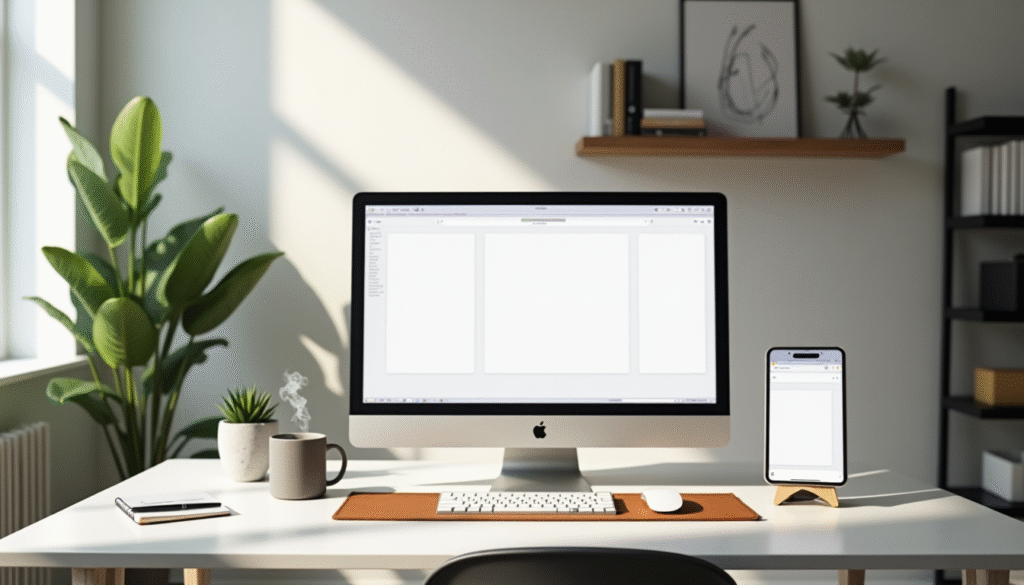Why Squarespace 7.1 Is Better: An Honest Review for 2025

Squarespace 7.1 delivers a revolutionary upgrade by expanding product limits from 200 to 10,000 items per page. This massive improvement benefits e-commerce sites substantially. The platform’s new features justify the lengthy migration process, which can take up to three months for a 150-page website.
The platform’s introduction of Fluid Engine, site-wide animations, and auto-layouts changes how websites are built on Squarespace completely. This new version boosts flexibility with nested categories for product collections. Squarespace’s site styles panel ensures improved design consistency, while its content editing capabilities provide powerful tools.
Your decision to upgrade your website deserves careful thought. We’ll get into Squarespace 7.1’s relevance in 2025 and explore its new features thoroughly. This honest review covers what works, what falls short, and essential information you need before switching.
What is Squarespace 7.1 and why it matters in 2025
Squarespace 7.1 came out in early 2020. It marks the rise of the platform’s development trip. Looking at the platform in 2025, regular updates and improved features have made it the life-blood of Squarespace’s ecosystem.
Overview of Squarespace version 7.1
Squarespace 7.1 works differently from its predecessor. The platform uses a “master template” system instead of various template families with different features. This change in architecture means all sites built on 7.1 share the same framework and features.
The platform’s biggest addition is the Fluid Engine—a true drag-and-drop editor that gives users exceptional layout flexibility. The 12-column grid system lets me place elements with pixel-perfect precision. This wasn’t possible in earlier versions.
The editor brings several improvements:
- Site-wide animations that add visual interest and user engagement
- Auto-layouts that arrange content sets in columns, rows, carousels, or slideshows
- Section backgrounds that work with both images and videos
- Portfolio pages that create stylized landing pages with links to sub-pages
The backend is more accessible in 7.1. Page building feels natural, especially when you have page sections that stack, reorder, and style individually.
What is the latest version of Squarespace?
Squarespace 7.1 remains the core platform version in 2025. The platform has received many feature updates since its original release. The company states that 7.1 “is the most recent version of Squarespace” and confirms that “version 7.1 features are regularly being improved, and new releases and functionalities are underway”.
Squarespace launched “Refresh 2024” in 2024. This major update brought AI-powered features to the platform. Blueprint AI stands out as it helps create custom websites through curated design and content recommendations.
Layout Switcher became part of Design Intelligence. It provides an adaptive layout menu for quick website design experiments. The system offers multiple flexible compositions with automatic content embedding. This shows Squarespace’s dedication to improving 7.1 rather than creating a new version.
Why Squarespace 7.1 is the future of the platform
Squarespace chose 7.1 as their platform for good reasons. The unified template system creates a better development path for new features. They can roll out improvements across the platform instead of updating multiple template families separately.
The platform delivers better performance. Sites load faster and respond better—especially on mobile devices. Your site will run faster than on 7.0, which matters for user experience and search rankings.
Squarespace develops new features only for version 7.1. Since 2020, they’ve focused on making 7.1 better while 7.0 gets basic updates. To access groundbreaking features like:
- Brand Identity Management
- Site Themes with one-click styling
- Enhanced client invoicing tools
- Expanded payment solutions
- New content monetization options
You’ll need to use 7.1. The platform combines design flexibility with business tools, making it valuable for entrepreneurs and small businesses in 2025.
The 7.1 platform shows Squarespace’s future direction. They continue to invest in AI features like Layout Switcher and Blueprint AI that work only with 7.1 architecture. Squarespace will support 7.0 “as long as people still use it”, but the gap between versions grows larger each year.
Unified templates: A simpler way to build
The Squarespace version 7.1 template system completely changes website building and customization. This new approach makes building easier while giving users more creative options.
How Squarespace 7.1 templates differ from 7.0
Squarespace 7.1 brings a major change by removing template families and creating a unified system. Users of version 7.0 found their template choice limited their site’s features and functionality. This often led to tough decisions as their websites grew.
Squarespace 7.1 templates work differently. “All Squarespace 7.1 sites are built on the same template and all Squarespace 7.1 sites offer the same functionalities”. Users no longer need to pick the “perfect” template at the start or worry about changing it later because of limitations.
The templates you see while choosing are really just design variations of one framework. A reliable source explains, “These predesigned templates have just been set up using the same starting point, but the fonts, colors and layouts as well as content have been adjusted to create a unique look”.
This change removes the stress of picking templates that came with 7.0, where certain features only worked with specific templates. Any design can now become any other look because they all work the same way. “Think of templates as different starting points” instead of rigid frameworks.
Benefits of having one template system
Squarespace version 7.1‘s unified approach helps both beginners and experts:
- Streamlined updates and maintenance – Platform improvements reach all sites at once
- More cohesive user experience – A consistent structure makes the platform easier to learn
- Easier customization – Design changes don’t require rebuilding
- No template-switching required – All templates share features, so starting over isn’t needed
The best part is that users can try different designs without losing any features. “If you get halfway through your site build and really wish you had picked another template, you don’t have to start over!”. Any design can become any look you want.
Squarespace 7.1‘s “Starting Points” make website creation easier. These pre-designed layouts save time and provide inspiration. Mobile optimization comes built-in. This helps achieve Squarespace’s goal to help users “make a great website fast”.
Impact on design consistency
The unified system makes websites look more professional and cohesive. All elements follow the same design principles.
The Site Styles panel lets users make global changes to colors, fonts, and spacing. One source points out, “Changes you make in site styles are usually site-wide, but you can make more fine-tuned changes by styling specific sections or text areas”.
Squarespace 7.1 adds “Section Themes” for visual variety while keeping designs consistent. These themes let you “change background colors and all font options based on a section”, adding flexibility without losing cohesion.
Saving and reusing sections speeds up the building process. “One of the easiest ways to build a website efficiently in Squarespace is to reuse previously designed sections… without having to design it from scratch each time”. This keeps design elements consistent throughout your site.
Enterprise users get a Design Library feature that creates “a hub for editing efficiency… that will transform the way you handle multiple websites”. This central hub ensures “a solid brand identity by keeping your site designs and copy consistent throughout your entire online presence”.
The unified template system shows how Squarespace 7.1 has changed website building by focusing on flexibility, consistency, and user needs rather than template restrictions.
Fluid Engine and layout flexibility
Fluid Engine represents the heart of innovation in Squarespace 7.1. This tool has changed the way websites come to life. The drag-and-drop editor gives users more creative freedom than ever before.
What is Fluid Engine in Squarespace 7.1?
Fluid Engine brings a fresh take on Squarespace’s editing system. The platform now offers better usability and new design options. The system works with a flexible grid – 24 columns on desktop and 8 on mobile. This setup lets users place elements with precision that wasn’t there before.
The classic editor in version 7.0 had limitations. Fluid Engine changes all that. Users can now move elements anywhere on the page and even overlap blocks. The screen becomes a canvas where elements resize with a simple drag. The old version didn’t allow this freedom. Elements could only sit above, below, or next to each other.
CSS Grid powers Fluid Engine’s core technology. Pages adjust smoothly to different screen sizes. This setup balances creative control with responsive design principles. A developer puts it well: “With infinite choice comes less confidence in layout design”. That’s why Squarespace added a grid system that guides without restricting creativity.
Fluid Engine shines with its separate desktop and mobile editing features. The mobile layout works independently from desktop, which means both versions look their best. Previous versions didn’t deal very well with mobile layouts, offering minimal control over the automatic generation.
How auto layouts improve design speed
Auto Layout sections in Squarespace 7.1 make design work faster. These layouts serve as workhorses to show grouped content like services, team members, or testimonials.
Auto Layouts come in three styles:
- Simple Lists – Stack all items neatly when the list needs attention
- Banner Slideshows – Show items one at a time with easy navigation
- Carousels – Display items in a rotating view
Auto Layouts excel in flexibility and speed. Moving items takes a quick drag-and-drop. Styles switch without rebuilding, and grouped elements keep consistent styling. Service packages might work best in a simple list, while testimonials shine in a carousel. No complex coding needed.
These layouts give users control over style choices. Card backgrounds, same-height items, spacing, and text size adjustments are all there. Creating attractive, unified sections takes less time.
Examples of creative layout possibilities
Fluid Engine paired with Auto Layouts creates design options that older versions couldn’t match. Blocks can overlap now, adding depth and visual interest beyond basic grid layouts.
Text placement becomes more dynamic. Words can float anywhere near images or content. Text can overlay images or create eye-catching asymmetrical designs.
The fluid layout system uses percentages instead of fixed widths. Elements adjust to any screen size automatically. This means designs stay consistent across devices without losing their appeal.
Creative professionals show what’s possible with Fluid Engine. They use Auto Layout carousels with custom-styled testimonials that match their brand. Service businesses pick Banner Slideshows to present offerings with smooth transitions. E-commerce sites create product categories using Simple Lists with custom borders.
The best part? These advanced layouts don’t require technical skills. Tasks that once needed custom code now work with simple drag-and-drop tools. This makes sophisticated design accessible to everyone, whatever their technical background.
New features that make a difference
Beyond the core architecture improvements, Squarespace 7.1 comes with standout features that lift the platform’s capabilities. These additions boost visual appeal and add more functionality that matters.
Site-wide animations and section backgrounds
Squarespace version 7.1 brings sophisticated animations that weren’t possible before. The platform now has five different animation styles that kick in as visitors scroll:
- Fade: Elements smoothly appear by increasing opacity
- Scale: Content zooms from smaller to larger
- Slide: Elements move upward into position
- Clip: Content slides in line-by-line from the left
- Flex: Adds effects to headings, links, and buttons including hover animations
You can customize these animations with three speed options—slow, medium, or fast—giving you control over how things look. Elements that don’t work with your chosen animation style switch to Fade animation, which keeps your site looking consistent.
Section backgrounds got a big upgrade in Squarespace 7.1. You can now add color gradients, custom patterns, and reposition images to create eye-catching page sections. If you know CSS, you can customize even more with code like:
section[data-section-id="YOUR-SECTION-ID"] .section-background {
background-color: #000000;
background-image: linear-gradient(180deg, #fce5e4, #ff7e59) !important;
}This gives you precise control over background image placement. You can adjust elements to make sure important parts of complex portrait images, like faces, don’t get cut off.
Portfolio pages and list sections
Portfolio pages are one of the biggest additions to Squarespace 7.1. These pages blend gallery and blog features to create stylish landing pages that connect visitors to sub-pages. They work great for showing off projects, organizing galleries, highlighting portfolio pieces, or featuring team members.
Portfolio pages work just like regular pages and support all standard Squarespace 7.1 sections while keeping a collection-based structure. You can add any section above or below your portfolio items and still get the benefits of collections.
List sections are a powerful tool that many people overlook. These flexible sections come with three layout options:
- Simple List: Shows all items at once (perfect for team pages)
- Banner Slideshow: Displays one item at a time with full-width background (great for featured work)
- Carousel: Shows items in a scrollable format (works well for testimonials)
List sections let you adjust image crop ratios, add card backgrounds with custom padding, and use infinite scroll. They adapt to mobile views automatically.
Improved commerce tools and digital products
Squarespace 7.1 makes e-commerce better by adding more digital product options. You can now sell access to gated content like courses, blog posts, videos, and member-only areas through different pricing plans.
Customers who buy digital downloads get two emails automatically: an order confirmation and download links. This makes selling digital products quick and easy.
The commerce experience has gotten better with these improvements:
- Weekly or monthly subscription sales
- More payment options including Stripe, PayPal, and Apple Pay
- Built-in waitlist for products
- Nested product categories for better organization
- Custom checkout forms for gift messages or special instructions
This is a big deal as it means that Squarespace 7.1 now handles up to 10,000 products, way more than before. With better inventory management and reporting tools, the platform works great for serious e-commerce businesses.
What’s missing in Squarespace 7.1
Squarespace 7.1 brings many improvements but comes with its share of trade-offs. The platform’s new features are great, yet some capabilities from the older version didn’t survive the update. These changes mean different things to various user groups.
Features removed from version 7.0
Users moving to squarespace 7.1 will find several beloved features from version 7.0 missing. The Developer Block’s removal hits hard – it let advanced users add custom HTML, CSS, and JavaScript into specific sections. This change affects people who relied on custom code to create specialized functions.
Squarespace version 7.1 has done away with template-specific features many users counted on. The Index Page system no longer exists – it used to let people create creative, scrollable homepage experiences. The platform also dropped support for parallax scrolling effects that added depth and visual interest to 7.0 sites.
Blog layouts changed completely in squarespace 7.1 templates. The old version’s sidebar options showed categories, recent posts, and subscription forms. The new blog architecture works differently and doesn’t use traditional sidebars. This reshapes how users present and organize their blog content.
The platform also limits several customization options that users once enjoyed:
- Cover pages with unique layouts separate from your main site design
- Some specialized gallery block styles and layout options
- Certain template-specific header variations and navigation styles
- Per-page sidebar customization capabilities
Workarounds and third-party tools
Squarespace 7.1‘s limitations have solutions through creative fixes or third-party tools. The Code Block still works for HTML and CSS, though with more limits, since the Developer Block is gone. The Custom CSS editor in Advanced Design lets users make site-wide style changes.
Section linking combined with anchor links can replace the Index Page feature. This approach takes more setup time but creates similar navigation experiences. The results aren’t exactly like the original feature, but they work well for most users.
Blog sidebars need more creative solutions. Some users create pseudo-sidebars by placing text blocks next to blog content. Others use tools like Brine Helper or CSS changes to bring back sidebar-like features.
External platforms like Juicer or Pixlee work well with squarespace 7.1 for better gallery options. These services connect through API or embedded content blocks and keep the design consistent while adding more features.
How these changes affect specific users
Different user groups face unique challenges with these updates. Web designers and developers feel the pinch most as squarespace 7.1 vs 7.0 moves toward simpler templates instead of advanced customization. They now have fewer options to create unique designs with custom code.
Bloggers and content creators might struggle with the new blog setup, especially if they used sidebar navigation or categories heavily. Learning the streamlined but less flexible 7.1 system takes time after using 7.0’s familiar blog layouts.
E-commerce businesses like the better product management in 7.1, but those with special catalog displays might feel restricted. The standard templates mean fewer ways to show products compared to 7.0’s template options.
Photographers and artists miss some gallery styles from the previous version. Squarespace 7.1 handles images better overall, but offers fewer unique presentation choices.
Of course, most users adapt to these changes over time. The improved stability and modern architecture of squarespace 7.1 make up for the lost features. Knowing these limits before upgrading helps set the right expectations and plan for workarounds.
The upgrade process: What to expect
The official migration tool released in late 2023 makes upgrading to Squarespace 7.1 a simple process. The transition needs good preparation and a clear understanding of the upgrade process.
Using the Squarespace 7.1 update tool
The Squarespace update tool helps site owners move from version 7.0 to 7.1 while keeping their data safe. You’ll find the tool under Website > Design > Update to Version 7.1. The tool starts by showing you a preview of your site’s new look after the upgrade. This preview is a vital step that lets you explore and tweak your 7.1 site before making any permanent changes.
Your live 7.0 site stays untouched while you make changes in preview mode. You can take your time in this phase until everything looks perfect. The migration becomes permanent when you click “Publish update” – there’s no going back after this step. Squarespace makes this clear: “After completing the steps in this piece, you can’t revert to version 7.0.”
Steps to prepare your site before upgrading
A good setup makes the squarespace 7.1 vs 7.0 migration much smoother:
- Create a backup – Make a copy of your website to keep track of your original design. Many experts suggest making two copies—one for safekeeping and another to practice with.
- Check template compatibility – Your site needs a template from the Bedford or Brine family. These are the only ones that work with the update tool.
- Disable developer mode – Switch off developer mode in Settings > Developer Tools. Save your custom code locally first since these changes will be gone after you disable it.
- Prepare for content changes – Squarespace version 7.1 doesn’t support album pages. These will disappear after the update. Save your text and audio files locally and think about creating new pages for this content.
- Review page count – The tool can handle up to 100 pages. Sites with more pages need cleanup or alternative solutions.
The prep work might feel like a lot, but it pays off. Site owners who spend time on proper preparation end up with a smoother migration experience.
Real-world use cases: Who benefits most
Understanding who benefits from Squarespace 7.1 helps you decide if upgrading makes sense in 2025. The platform’s development has created clear advantages and potential risks for different groups of users.
Best for new users and small businesses
Squarespace version 7.1 works great for people starting their online presence. New users find it more user-friendly and straightforward than 7.0. The platform provides an easier starting point if you’re new to Squarespace or had trouble with the previous version.
Small businesses benefit greatly from improved e-commerce features. They can now list up to 10,000 products per page instead of just 200. The platform also accepts various payment options including Apple Pay, PayPal, Klarna, and Afterpay through Squarespace Payments. Users can manage all their finances from a single dashboard.
When it’s worth upgrading from 7.0
Squarespace 7.1 works best for websites that need major changes. The perfect time to switch is during a redesign, rebranding, or big content update. You can utilize new design tools while making needed changes. The upgrade process becomes more efficient when combined with planned updates.
E-commerce sites benefit the most from switching. Squarespace 7.1 vs 7.0 brings useful improvements like nested categories, waitlists for sold-out items, and better product detail pages. These features make the switch worthwhile for businesses that feel limited by 7.0.
Who should wait or avoid upgrading
Not everyone gets equal value from Squarespace 7.1 templates. Sites with heavy customizations in developer mode should be careful because these changes will be lost during the switch. Websites that rely heavily on custom code might need extensive rebuilding after the upgrade.
Websites with more than 100 pages face special challenges due to the update tool’s page limits. These sites need a Squarespace expert to ensure a smooth transition. Without doubt, complex websites need professional help rather than trying to upgrade alone.
Your current 7.0 site might work perfectly fine for your needs. Squarespace will keep supporting 7.0, so you can upgrade when it fits your business goals instead of rushing into it.
Performance, SEO, and mobile experience
Performance metrics play a vital role in evaluating website platforms in 2025. Squarespace 7.1 brings improvements by a lot in both technical performance and search engine optimization capabilities compared to its predecessor.
How 7.1 affects site speed and SEO
Squarespace version 7.1 loads pages faster than 7.0. The platform’s speed boost comes from technical optimizations specific to the 7.1 architecture. Squarespace engineers have confirmed these improvements won’t make their way to older 7.0 templates.
Squarespace 7.1 offers several valuable SEO advantages:
- Text elements like blog post titles automatically receive H1 tags
- Native Heading 4 settings maintain proper content hierarchy
- No more index pages that created duplicate content problems
- Gallery Sections now include built-in alt text functionality
Search engines can better understand your site’s content organization thanks to these structural improvements. The platform strategically places relevant keywords in sections that matter to search algorithms by defining your site’s semantic markup automatically.
The unified template system boosts technical SEO benefits. Your SEO doesn’t change as much when switching designs as it did in 7.0 since all sites share the same foundation. Your search rankings benefit from this long-term stability.
Mobile responsiveness in Fluid Engine
Squarespace 7.1‘s Fluid Engine revolutionizes mobile optimization. The previous version generated mobile layouts automatically from desktop arrangements. Now, Fluid Engine lets you edit mobile layouts independently.
You can arrange and resize elements specifically for mobile without affecting desktop layouts. The mobile editor uses an 8-column grid system that gives you precise control over content appearance on smaller screens.
The mobile editing capabilities let you:
- Change block positions for better mobile viewing
- Adjust element sizes for touch interfaces
- Create visually interesting mobile-specific overlaps
Getting the best results with Squarespace 7.1 templates requires checking the live mobile version after editing. Elements might expand or shift unexpectedly. On top of that, text alignment and button fit options apply to both desktop and mobile views.
Designing for both desktop and mobile takes more work in Squarespace version 7.1. The improved control ended up delivering a better mobile experience by a lot—a vital factor since mobile traffic leads web usage in 2025.
Conclusion
Squarespace 7.1 is a major upgrade that handles many of its predecessor’s limitations effectively. The platform’s improved features make it worth thinking about, though migration needs careful planning. This is particularly true for sites with custom code or those exceeding 100 pages.
The new unified template system makes website building simpler and opens up more creative options. Users can build professional-looking websites faster with Fluid Engine’s precise layout control. Auto Layouts and better mobile editing add to these capabilities.
My hands-on work shows that new users and growing e-commerce businesses get the most value from version 7.1’s user-friendly interface and higher product limits. The platform looks promising with its better performance and SEO benefits, even though some 7.0 features didn’t carry over. Regular updates keep adding new functionality.
You should take time to review your specific needs against 7.1’s capabilities before upgrading. A full preparation will help you move smoothly to this more powerful Squarespace version.
FAQs
Q1. What are the main advantages of Squarespace 7.1 over previous versions? Squarespace 7.1 offers a unified template system, improved design flexibility with Fluid Engine, enhanced e-commerce capabilities, and better performance. It also provides more intuitive site-building tools and expanded product limits for online stores.
Q2. How does Squarespace 7.1 improve mobile responsiveness? The Fluid Engine in Squarespace 7.1 allows for independent mobile editing, enabling users to create custom layouts specifically for mobile devices. This feature provides greater control over how content appears on smaller screens, resulting in a significantly improved mobile experience.
Q3. Is it worth upgrading from Squarespace 7.0 to 7.1? Upgrading to Squarespace 7.1 is particularly beneficial for websites undergoing significant changes, e-commerce sites looking to expand, and those seeking improved performance and SEO benefits. However, sites with extensive custom code may face challenges during migration.
Q4. What features were removed in Squarespace 7.1? Some features removed in Squarespace 7.1 include the Developer Block, Index Pages, certain template-specific features, traditional blog sidebars, and some specialized gallery block styles. However, workarounds and third-party tools can often address these limitations.
Q5. How does Squarespace 7.1 impact site speed and SEO? Squarespace 7.1 generally offers faster loading times compared to 7.0 due to technical optimizations. It also introduces SEO improvements such as automatic heading tag creation, better content hierarchy, and elimination of duplicate content issues, potentially leading to better search engine rankings.
More on Afrishervi







